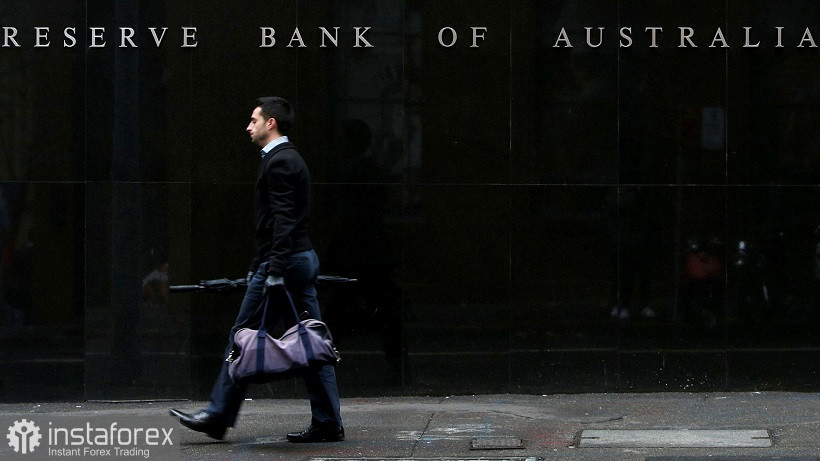The AUSD/USD pair updated its almost one and a half year price low last Friday, reaching the level of 0.6994. The last time the pair was below the key support level of 0.7000 was in July 2020. However, the bears could not consolidate within the area of 0.69 – as soon as they passed the border, the downward impulse instantly disappeared.
Last Friday, the Australian dollar declined by more than 100 points, but still could not break through the most important price barrier. During today's Asian session, the pair showed an upward correction but was weak and uncertain. Before tomorrow's event, traders are hesitant to open large positions, and even more so in favor of the AUD. The fact is that the Reserve Bank of Australia will summarize the results of the last meeting this year tomorrow. Considering the new coronavirus threat and weak macroeconomic reports, it can be assumed that the RBA members' rhetoric will be exclusively "dovish".

It can be recalled that the Australian regulator took a wait-and-see attitude after the results of the November meeting, despite the slowdown in the labor market after a prolonged lockdown. On the one hand, the failed "Australian Nonfarm" put an end to the issue of a possible acceleration of the pace of curtailing the incentive program. On the other hand, the Central Bank did not revise its plans for its completion. RBA representatives said they would buy government securities at a $4 billion rate per week until mid-February next year. According to general forecasts, the volume of QE will be reduced to 3 billion at the February meeting. As for the fate of the interest rate, the markets are putting an early start to the tightening of the RBA's monetary policy in prices starting from July next year. Several experts said that the Australian Central Bank will have to react to a strong increase in inflation, which will be observed both in the fourth quarter of this year and in the first quarter of next year. In the third quarter of this year, the general consumer price index came out in accordance with the preliminary forecasts of most experts. The indicator increased to 3.0% in annual terms, and to 0.8% in quarterly terms. According to the RBA, the core inflation index (by the truncated average method and the weighted median method) also demonstrated positive dynamics.
It should be noted that not all experts agree with the implementation of the "hawkish" scenario. On the contrary, 16 out of 25 economists surveyed by Reuters said that they expect the RBA to raise the first rate "no earlier than the first quarter of 2023." Other experts named more distant dates, namely the third-fourth quarter of the 23rd year.
In my opinion, the head of the Central Bank, Philip Lowe, will calm down the AUD/USD bulls at the end of tomorrow's meeting, refuting the likelihood of a rate hike next year. Earlier in one of his speeches, he said that the hawkish expectations of the market are extremely unrealistic.
Apparently, Lowe will repeat this thesis tomorrow, especially amid the growing uncertainty associated with the spread of the new COVID strain Omicron. The Australian regulator will also evaluate the latest data in the labor market. It can be recalled that the last published figures were disappointing. In particular, the unemployment rate rose to 5.2% in October. The indicator showed growth after a 10-month consecutive decline. The increase in the number of employed was also disappointing. Contrary to forecasts of growth to 50 thousand, it collapsed into the negative area, having decreased by 46 thousand. This indicator also came out in the negative zone in August and September. However, there was a strict lockdown in these months in the largest states of the country. And in early October, the federal authorities of the largest regions of Australia relaxed quarantine restrictions, so experts expected a minimal, but still an increase in the number of employed.

In my opinion, the Reserve Bank of Australia does not have any clear reason to tighten its rhetoric. Most likely, the regulator will maintain the status quo, confirming its intentions to complete the bond purchase program next spring. The regulator may also voice concerns about the spread of Omicron. At the same time, it is unlikely that Philip Lowe will follow the example of Jerome Powell, who advocated an early curtailment of QE. And although some analysts admit such a scenario, we believe that the probability of its implementation is minimal.
Most likely, the Australian dollar will be under background pressure at the end of the RBA's December meeting, continuing to move in the wake of the US dollar. From a technical point of view, the AUD/USD pair on the D1, W1, and MN timeframes is located between the middle and lower lines of the Bollinger Bands indicator, as well as under all the lines of the Ichimoku indicator, which formed a bearish "Line Parade" signal on D1 and W1. The main support level is the "round" and psychologically important level of 0.7000. If the bears of the pair still push this target, then the next target will be the price of 0.6950 – this is the lower line of the Bollinger Bands indicator on the four-hour chart.
 English
English 
 Русский
Русский Bahasa Indonesia
Bahasa Indonesia Bahasa Malay
Bahasa Malay ไทย
ไทย Español
Español Deutsch
Deutsch Български
Български Français
Français Tiếng Việt
Tiếng Việt 中文
中文 বাংলা
বাংলা हिन्दी
हिन्दी Čeština
Čeština Українська
Українська Română
Română

